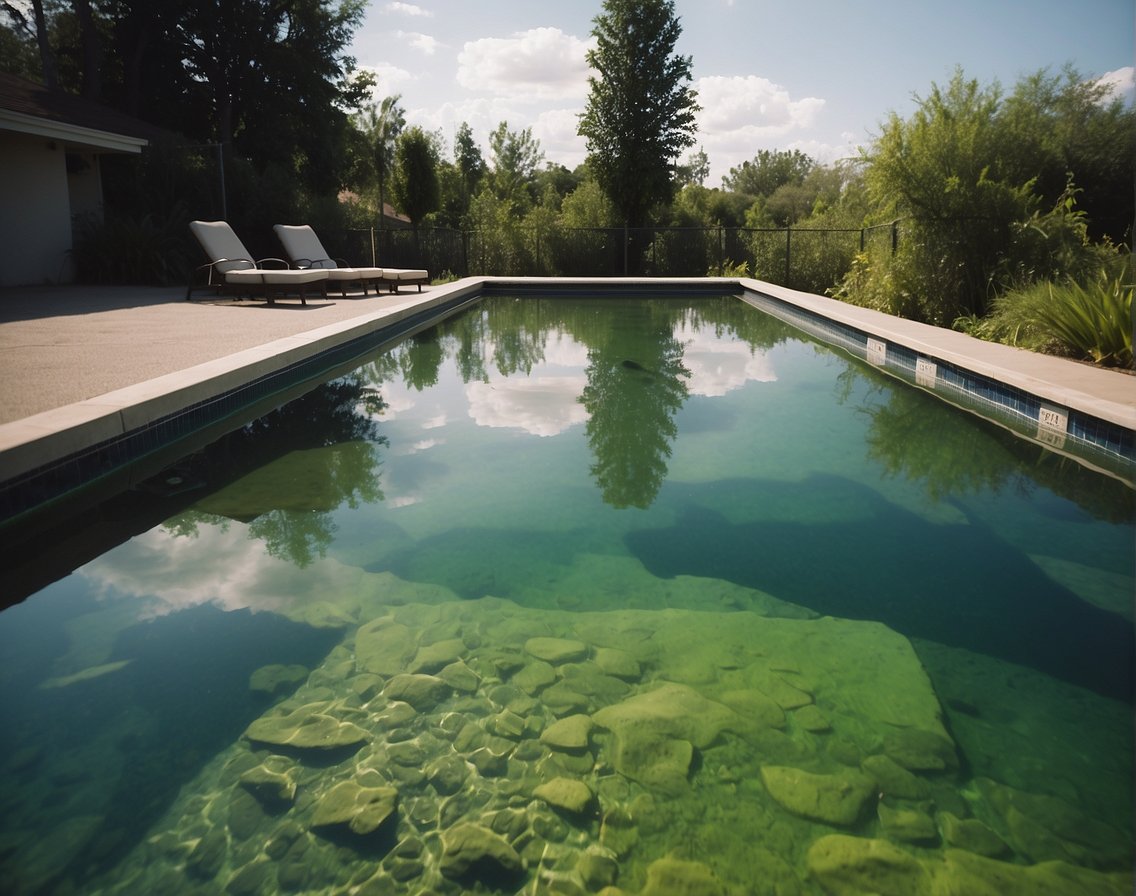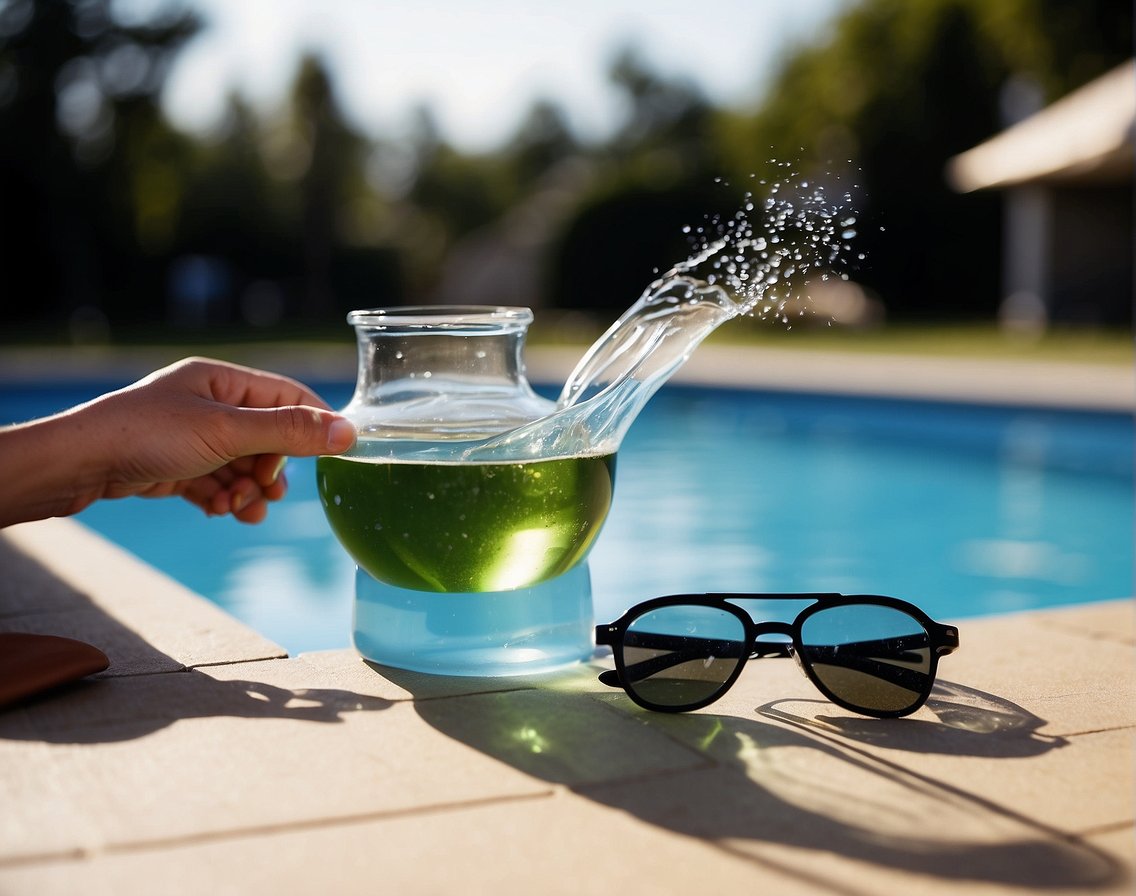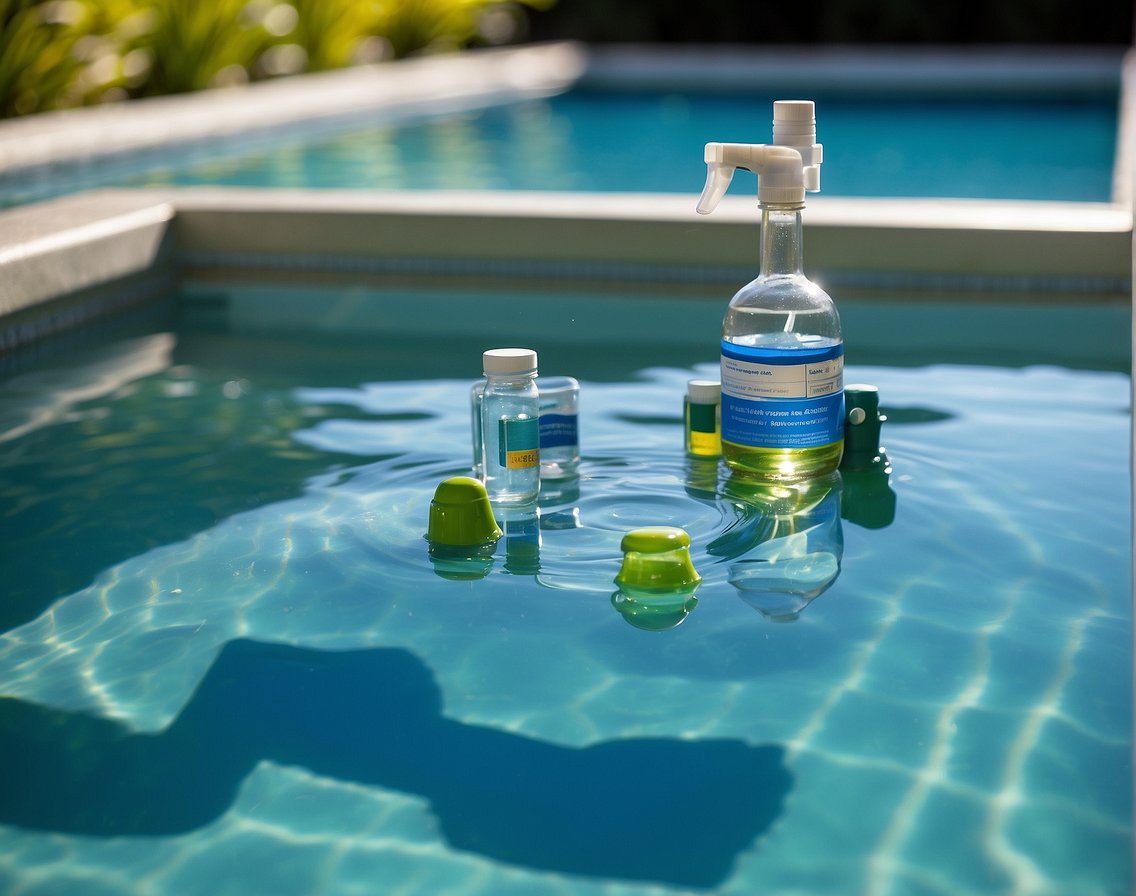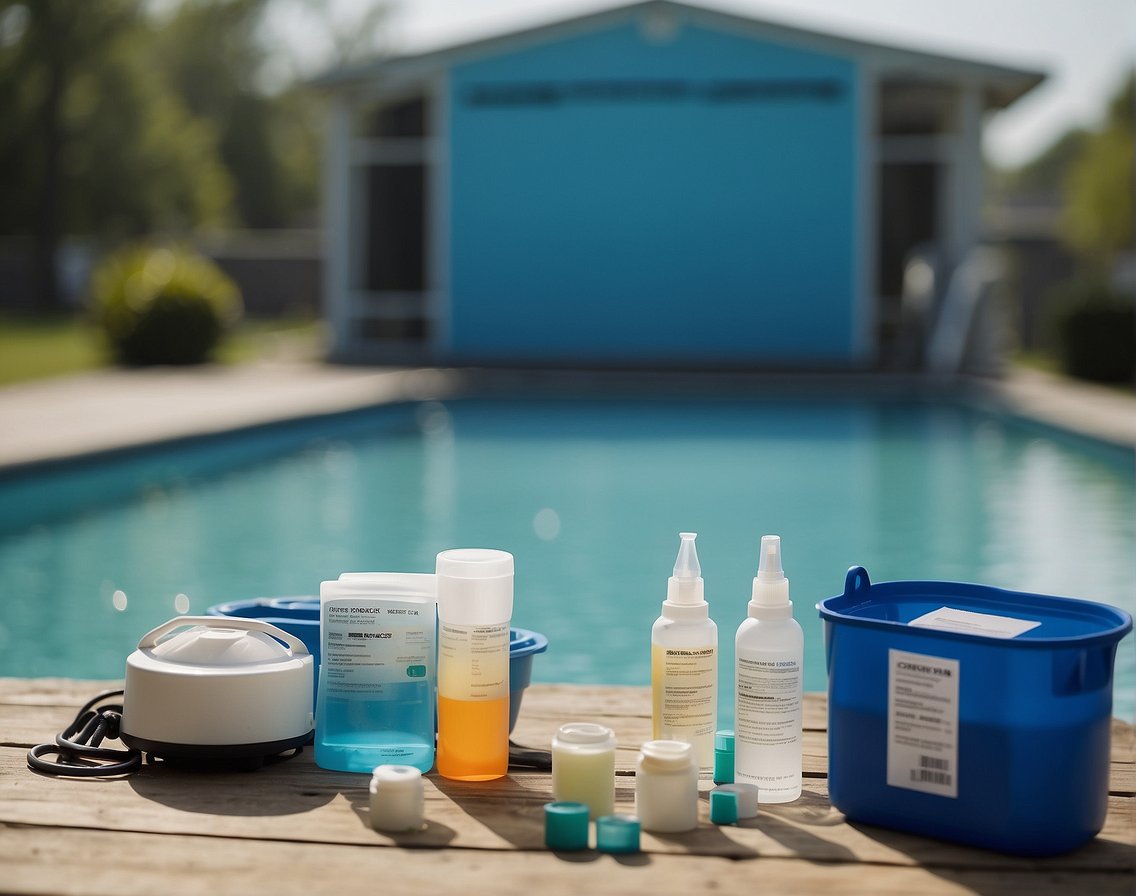Understanding Pool Chemistry Fundamentals

In maintaining a healthy swimming pool, understanding and adjusting chemical levels is crucial. Our goals are to prevent corrosion, skin irritation, and the proliferation of bacteria.
Importance of Maintaining pH Levels
The pH scale measures how acidic or basic water is, ranging from 0 to 14. We aim for a pH level between 7.2 and 7.8, as this range is optimal for swimmer comfort and effective sanitizer performance. If pH levels deviate, pool water can turn corrosive or scale-forming, causing damage to the pool and discomfort to swimmers.
The Role of Total Alkalinity in Water Balance
Total Alkalinity (TA) serves as the buffer for pH levels, helping to stabilize them despite chemical additions or environmental factors. We maintain TA levels between 80-120 ppm (parts per million) to protect water quality and prevent sudden pH changes. Consistent TA levels enable us to manage pH balance with more predictability and ease.
Calcium Hardness and Its Impact on Pool Surfaces
Calcium hardness refers to the amount of dissolved calcium in the pool water. The ideal range is 200-400 ppm. Water with low calcium hardness can become aggressive and etch surfaces, while high levels can lead to calcium deposits. We closely monitor calcium hardness to protect the integrity of the pool liner and other surfaces.
The Function of Sanitizers in Pool Maintenance
Sanitizers, like chlorine, are essential to keep pool water safe by eliminating pathogens. The effectiveness of sanitizers is closely linked to the pH level; improper pH can render sanitizers ineffective. We ensure sanitizer levels remain within the recommended range of 1-3 ppm for chlorine, which is critical for maintaining water balance and pool water quality.
Routine Testing and Adjusting Chemical Levels

Regular testing is crucial to ensure the pool water is safe and comfortable for swimmers. We’ll guide you in using test kits effectively, adjusting chemicals accurately, and maintaining the ideal chemical balance.
How to Use Test Kits for Accurate Measurements
Using testing kits is essential for maintaining pool water chemistry. To begin, we’ll gather a sample of pool water from about 18 inches below the surface to avoid any skewed readings from the water surface. The test kit should include reagents or testing strips for measuring free chlorine, total chlorine, pH, total alkalinity, calcium hardness, and cyanuric acid.
- Free Chlorine should register between 1-3 ppm.
- pH Levels are ideal between 7.4 and 7.6.
- Total Alkalinity is best kept between 80 and 120 ppm.
- Calcium Hardness should be within 200-400 ppm.
- Cyanuric Acid levels ought to be maintained at 30-50 ppm, aiding in chlorine stability.
Consistency in testing is key; we perform these tests at least once a week, or daily if the pool sees heavy use.
Adjusting Pool Chemicals for Optimal Water Quality
After testing the water, we adjust pool chemicals accordingly. If the pH is low, we gradually add pH increasers, while high pH levels require pH decreasers. Following manufacturer instructions and dosages is pivotal. We add chemicals to different parts of the pool to avoid concentrated areas that may damage the pool surface or equipment. We wait about two hours for the chemicals to circulate before retesting.
Addressing Fluctuations in Chlorine and pH
Chlorine and pH levels can fluctuate frequently. When chlorine levels fall below 1 ppm, we add either chlorine granules or liquid chlorine. As for pH adjustments, we add increasers or decreasers in small amounts, retesting after each application until we achieve the desired levels. High levels of Combined Chlorine (CC), above 0.5 ppm, indicate the need for additional chlorine to sanitize the pool water effectively.
Applying Pool Shock and Sanitizers Correctly
Pool shock, a large dose of chlorine, is necessary as a part of regular maintenance or after heavy use. It’s also used if the water tests show high levels of bacteria or algae. We typically apply shock treatments in the evening, after the sun has set, to prevent UV rays from dissipating the chlorine. We distribute the pool shock evenly across the water’s surface and avoid swimming until chlorine levels return to 3 ppm or less. For daily sanitization, a steady release of chlorine helps maintain a constant level of free chlorine in the pool.
Incorporating algaecide as part of the maintenance schedule after shocking can assist in preventing algae blooms. We always monitor the balance of pool chemicals closely to ensure the safety and comfort of all swimmers.
Preventing and Handling Common Pool Problems

To ensure a healthy and enjoyable swimming environment, we must regularly monitor and address the chemical balance of our pool. This includes preventing and handling algae growth, maintaining clear water, and avoiding damage to pool surfaces and equipment.
Algae and Bacteria: Causes and Solutions
Algae and bacteria thrive in pools due to factors like poor sanitation, improper pH levels, and stagnant water. To combat these contaminants, we maintain adequate chlorine levels and use algaecides specifically designed to target algae. It’s crucial to keep the pool’s pH level between 7.2 and 7.8; this allows the chlorine to act effectively. Routine brushing and vacuuming remove algae spores and prevent them from establishing a foothold.
- Key Measures:
- Regularly test and adjust pH and chlorine levels.
- Apply algaecides as needed.
- Scrub and clean pool walls and floor regularly.
Dealing with Cloudy Water and Scaling
Cloudy water and scaling are often symptomatic of imbalanced calcium hardness or high pH levels. To address this, we check the calcium hardness regularly and aim for a range of 200-400 ppm, adjusting as necessary using calcium chloride. Filtering systems should be cleaned and run efficiently to capture particulates that contribute to cloudiness. Moreover, reducing the pH slightly with an acid, such as muriatic acid, can help clear up the water and prevent scaling.
- Optimal Ranges:
- Calcium hardness: 200-400 ppm
- pH: Slightly lower to avoid scaling
- Prevention Strategies:
- Utilize pool filters effectively and clean them frequently.
- Adjust calcium hardness with calcium chloride if needed.
Avoiding Corrosion and Equipment Damage
Corrosive water, which can damage pool equipment, occurs when pH levels drop too low or specific chemicals are imbalanced. To protect our pool equipment, we strive to prevent acidic conditions by maintaining a balanced pH and alkalinity. Regular inspections of pumps, heaters, and ladders are important to detect early signs of corrosion. Applying a sequestering agent can help manage metals in the water that accelerate corrosion. We also ensure that sacrificial anodes are in place to protect metal components.
- Maintenance Checklist:
- Maintain balanced pH and alkalinity to prevent acidic water conditions.
- Inspect and replace sacrificial anodes regularly.
- Use sequestering agents to control metal levels in the pool.
Advanced Pool Care Techniques

In mastering the intricacies of pool maintenance, we focus on innovative sanitization methods, precise volume calculations, and the application of the Langelier Saturation Index to ensure a stable and balanced aquatic environment.
Exploring Alternative Sanitization Methods
Introducing alternative sanitization methods can significantly enhance our pool’s water quality. Chief among these methods are biguanide-based sanitizers, non-chlorine options that eliminate bacteria and pathogens while being gentle on the skin and eyes. On the other hand, mineral systems use elements like silver and copper to purify water, reducing the need for traditional chlorine. Additionally, salt generators, also known as saltwater chlorinators, convert salt into chlorine, thereby softening the water and providing a more natural feel. All these alternatives require us to understand their distinct operational guidelines and balancing requirements to keep the pool water healthy.
Utilizing Pool Volume Calculations in Chemical Balancing
Accurate pool volume calculations are critical to maintaining chemical balance. Here’s a basic calculation method:
- Rectangular pools: length x width x average depth x 7.5 = volume in gallons
- Circular pools: diameter x diameter x average depth x 5.9 = volume in gallons
Our meticulous calculation enables precise dosing of chemicals, such as stabilizers or conditioners, ensuring balanced pool water. Stabilizers protect chlorine from UV degradation, increasing the effectiveness of the sanitization process.
Interpreting the Langelier Saturation Index for Pool Stability
The Langelier Saturation Index (LSI) is a crucial tool for assessing pool water balance. It considers factors like pH, total alkalinity, calcium hardness, temperature, and total dissolved solids to determine the water’s corrosivity or scaling potential. The index ranges from -3.0 to +3.0, with a score between -0.3 and +0.3 indicating balanced water. Here’s how to interpret LSI values:
- LSI < -0.3: The water is under-saturated, leading to corrosion.
- LSI between -0.3 and +0.3: The water is balanced.
- LSI > +0.3: The water is over-saturated, which can lead to scaling.
Ensuring our pool water falls within the balanced range of the LSI helps to prevent damage to pool surfaces and equipment. Regular testing and adjustments based on LSI readings can maintain a stable swimming environment and prolong the lifespan of our pool.
Maintaining a Safe Pool Environment

To ensure the safety of all pool users, we must prioritize chemical management and the use of personal protective equipment during maintenance tasks.
Proper Storage and Handling of Pool Chemicals
Proper storage of pool supplies is critical to maintaining safe pool chemistry. Pool chemicals such as muriatic acid, bromine, sodium bisulfate, sodium carbonate, and sodium bicarbonate should be stored in a cool, dry place away from direct sunlight and temperature extremes. They should be kept off the ground on shelves to avoid moisture absorption and to reduce the risk of containers becoming compromised.
Chemicals such as liquid chlorine and granular chlorine should be stored separately to prevent any chemical reaction that might occur if they accidentally come into contact. Always use dedicated, clean scoops for each chemical to avoid cross-contamination. After handling chemicals, ensure that containers are sealed tightly to maintain the potency of the chemicals and to prevent any potential leaks or spills.
For balancing pool chemicals, utilize tools such as a saturation index calculator to accurately assess water balance parameters, including water hardness, total dissolved solids, and temperature. Keeping track of these factors helps prevent issues with pool chemistry and reduces the likelihood of outbreaks caused by germs.
Personal Protective Equipment for Pool Maintenance Tasks
When performing pool maintenance tasks, wearing the appropriate PPE (personal protective equipment) is essential to prevent exposure to hazardous chemicals and materials. At a minimum, we should wear gloves and safety goggles when handling chemicals such as sanitizers or flocculants. In certain situations, such as when pouring or mixing chemicals like muriatic acid, a face shield and apron can offer additional protection.
It’s important for pool owners to understand that pool maintenance involves more than just using a pool vacuum and removing debris—it’s about ensuring a well-balanced aquatic environment. By implementing safe chemical storage practices and using the correct PPE, we support a clean and enjoyable pool while safeguarding our health and the well-being of all pool users.
Frequently Asked Questions
In this section, we provide clear, step-by-step answers to common questions pool owners have about chemical balancing for regular maintenance and troubleshooting problems.
What steps should I follow to initially balance the chemicals in my pool?
To start, we test the pool water to determine its current chemical levels. We then adjust the pH, alkalinity, and sanitizer levels in that order. Ensuring your pool’s filter system is clean and running efficiently is also crucial during this initial balancing.
What is the correct order for adding chemicals to balance my pool water?
When adjusting pool chemicals, we always begin with balancing the total alkalinity since it stabilizes the pH. Once alkalinity is within the correct range, we adjust the pH level. Only after these levels are stabilized do we focus on sanitizer levels, such as chlorine or bromine.
Why is my pool water still green even though the chemical levels seem balanced?
A green pool, despite balanced chemical readings, often indicates an algae issue. We remedy this by shocking the pool, which involves adding a high chlorine dose to eradicate algae, and then we verify the filtration system is functioning properly to remove dead algae.
How do I adjust the pH and alkalinity levels in my pool effectively?
To raise pH and alkalinity, we use a base like sodium carbonate (soda ash). If we need to lower pH, we use muriatic acid or sodium bisulfate, and we handle both chemicals with care. It’s important to add these chemicals slowly in separate areas of the pool to prevent localized high concentrations.
What is the best method to check and maintain chemical balance in pool water?
Regular testing with a reliable pool test kit is essential for maintaining chemical balance. We test at least once a week and more frequently during heavy use or extreme weather. Consistent recording of the results helps us monitor trends and adjust chemicals as needed.
How can I correct a chemical imbalance in my swimming pool after heavy usage?
After heavy usage, we conduct a thorough test of the water and re-balance the chemicals beginning with the total alkalinity, followed by pH, and then sanitizer levels. We may need to shock the pool if there are signs of algae growth or if the sanitizer levels have dropped significantly.
